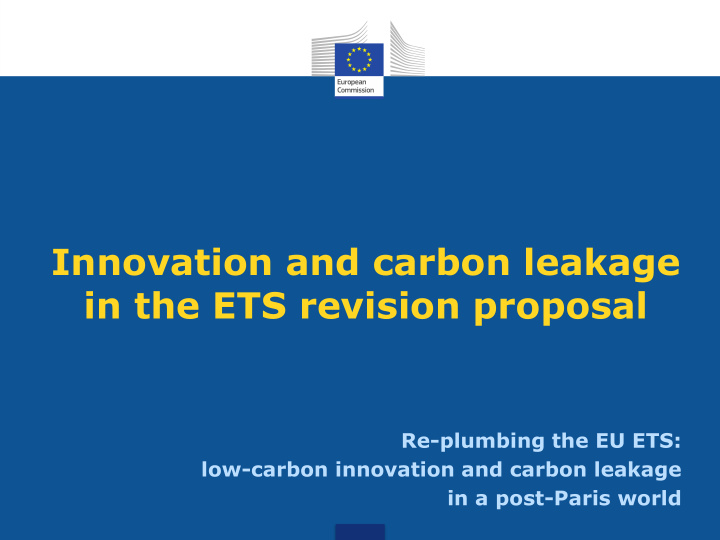



Innovation and carbon leakage in the ETS revision proposal Re-plumbing the EU ETS: low-carbon innovation and carbon leakage in a post-Paris world
Roadmap: 2050 low-carbon economy • The transition to a low-carbon economy is feasible and affordable, but requires innovation and investment • Investment in today's abatement technologies • Innovate to develop future abatement technologies
ETS revision proposal: innovation and carbon leakage Low-carbon funding mechanisms • Innovation fund • • 450 million allowances up to 2030 Free allocation and carbon leakage • free allocation to continue • • 6.3 billion allowances from 2021 to 2030 benchmarks to be updated • two carbon leakage groups • more flexible production data • avoid / minimise need for correction factor •
Innovation fund • Scope : innovative low-carbon technologies: RES, CCS and expansion to cover industry • Companies across all Member States to compete for available funds • Better risk sharing: • Covering risk earlier in project life cycle: 40% of funding can be given based on milestones achieved before project is operational • Support rate: up to 60%
… building on NER300 experience • NER 300 funding: € 2.1 billion (300 mio allowances) • 38 projects in 19 EU Member States: • 37 RES and 1 CCS • State-of-play (1 st call) • 3 projects in operation • 5 reached positive FID
… building on NER300 experience ctd. • Delays : many projects late reaching final investment decision and start of operations • Barriers : investment challenge because of economic (e.g. market development) and regulatory factors (e.g. interaction RES subsidy changes) • CCS : many proposals not confirmed by MS, existing funding insufficient for business case • Resources : reflect carbon price at time of monetisation
NER 300 lessons learned • Address risk : it's not just about the level of funding, but how and when it is provided. Earlier funding may help to address project risk • Flexibility is important : if money had been ring- fenced, € 750m would be unused • Complementarity helps : support for commercial demonstration should be well aligned with steps before (R&D) and after (deployment) • Monetisation : frontloading created gap between impact on carbon market and use of funds
Benchmark values Ambition drives innovation • 2008 data, benchmarks 22 years old in 2030! • EU leaders: regular review of benchmarks to reflect technological progress • Proposal for update based on 3 standard rates and classification based on verified data • Advantages : • Preserves overall benchmarking architecture • Rewards innovation • Simple and predictable • Major elements decided in Directive
Conclusions • Innovation is key for successful transition to low- carbon economy • Support for innovation and carbon leakage rules are complementary ('two sides of a coin') • Revision proposal aims to facilitate, strengthen incentives for and reward innovation
Recommend
More recommend